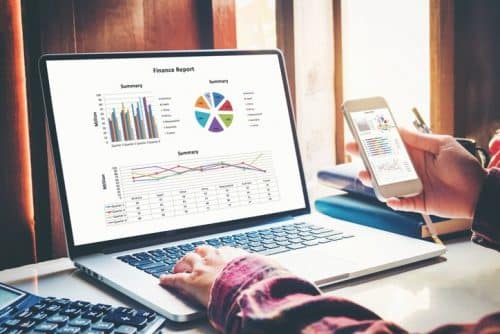We’ve all had the experience of looking for a product on Amazon (or in your local store) only to discover it’s unavailable or out of stock. Yeah, it’s a common customer concern, but it’s an even bigger issue when it comes to supply chain management. What is the solution? Well, demand forecasting/planning software tools are the answer.
The power of forecasting is brought into a company’s processes by demand planning softwares. Overtime, these tools allow you to better serve your consumer base by preparing your output and inventory ahead of time rather than responding to market changes at every turn – an important part of business success. After all, if you don’t regularly satisfy customers’ demands in a timely manner, you won’t be able to pull in money and keep the lights on.
So, how do you know which solution would provide the best return on investment for your unique needs? What are the most effective options available?
If you’re anything like me, get a cup of milk and a slice of cake and settle in. We are about to take a look at the big picture before drilling down to the best options and what they have to offer.
What is Demand Planning and How Does It Work?
Demand forecasting, according to some experts, is an “important phase in supply chain planning.” This phase helps to produce accurate forecasts for company use. Demand planning, on the other hand, goes beyond just statistics, which sets it apart from demand forecasting software. The following are the steps in the process of planning :
- Form a team that includes people from distribution, logistics, and technology.
- For statistical forecasting, combine and review the results.
- Include new data, such as product sales relative to similar sales from competitors. Also, revise the model and projections as necessary.
Moving on, something else you should know about demand planning is its relationship with demand management.
Relationship Between Demand Planning & Management
Demand planning and demand management are identical, but instead of twins, think of them as siblings – related but distinct. Short-term supply and demand problems are dealt with by demand management tools. Demand planning, on the other hand, considers the long-term perspective. It allows decision-makers to look forward to future demand rather than being stuck in the moment; thanks to predictive analytics.
With this knowledge, the company will be better positioned to meet future consumer demands by keeping enough inventory on hand. What’s the end result? Increased revenue as a result of the opportunity to satisfy demand.
Meanwhile, demand planning is sometimes used as part of a larger supply chain management software kit (SCM). But why SCM? This is because when raw materials arrive at company locations, they are stored in order to produce the goods that will be delivered to consumers if demand arises. Demand planning will basically help to strengthen the supply chain process. Reason being that it provides you a clearer perspective of what will be ordered in the future.
By using demand forecasting and planning to improve product life cycles and ROI, your company literally benefits from this type of market intelligence.
What You should know about Demand Planning and Forecasting Softwares
Let’s take a closer look at planning and forecasting software for a moment.
#1. Trends Monitoring in Real-Time
The supply chain is a network of technologies, processes, and people that is diverse and interconnected. A never-ending river of data serves as the engine at the heart of it all. Operating a company without data knowledge is equivalent to piloting a Boeing 747 through a thunderstorm without the device functioning. You’ll be flying blind.
This is why, according to over 80% of manufacturers, real-time monitoring is critical to their success. It puts the data in perspective and reveals problem areas while also providing insight into topics like product quality and machine efficiency. This exposure aids in keeping the company afloat.
#2. Knowledge Sharing Networks
Information sharing networks are the product of integrations through BI, analytics, track-and-trace applications, and quality control. Basically, while on-premise legacy systems are combined with 3rd-party and cloud applications, a platform is created that allows for supplier connectivity as well as increased speed and scalability.
#3. Collaboration
The vast amount of data available at our fingertips emphasizes the importance of cooperation around the supply chain. For the most part, data quality and reliability are critical, but businesses often rely on data that offers a single version of the facts that can be exchanged easily in order to cut costs and waste while improving performance.
Collaboration should include all departments of an organisation, as well as retailers and suppliers, if they’ll be successful.
#4. AI and Machine Learning
AI is now as popular as peanut butter, and Gartner estimates that its global market value will hit nearly $4 trillion by 2022. Despite the fact that it, like machine learning, has yet to be widely adopted in the supply chain industry, that is about to change.
This is no surprise, considering their capabilities, which include:
- Contextual intelligence reduces costs and inventory while accelerating response times.
- Improving plant scheduling and other processes
- Forecasting arrivals and departures of warehouse orders
- Recommendations on how to improve SCM efficiency
- A 360-degree view of the supply chain is available.
#5. Cloud Solutions
Cloud platforms are primed for greater usage going forward, as businesses address concerns about security and uptime that come with 3rd party vendors having access to apps.
Also, globalization is another element. Companies need simpler and more efficient ways to standardize processes as they navigate global supply chains.
So, basically cloud systems are a viable option.
Importance
Forecasting is an essential aspect of demand planning. You’ll need powerful tools that can process large amounts of data to make your plans a reality. You should know by now that, inventory and resource projections cannot be made up out of thin air. They must be based on facts.
How do you come up with these ideas? You can remove and separate data from reports, feedback, metrics, and surveys using software solutions that provide forecasting, such as business intelligence tools. Youu can transform thes e findings into actionable statements. For example, i f a certain group has a peak purchasing time, demand planning and forecasting software may detect it by analyzing thousands of reports.
Needs Analysis
Rather than focusing on the most comprehensive goods, search for softwares that meet your needs. An “almost” match will not suffice. The real emphasis should be on monitoring demand sources and drivers so that technology can help your operations effectively.
Furthermore, pick a product with a clear interface if you have no experience. To collect graphs, maps, and diagrams, many solutions use simple dashboard interfaces. Eventually, this will shorten your system’s learning curve, allowing you to use it more quickly in your business.
Also it’s better to invest in a system with a wide range of functions that you’ll actually use. In other words, you should avoid bells and whistles that cost extra but aren’t needed, as with any demand planning software. In an ideal world, you’d be able to delve into the complexities of analytics without compromising productivity or user-friendliness.
Consider the importance of the following factors based on your specific requirements to ensure a good fit:
- Forecasting from the top-down and the bottom-up
- Seasonality and causality
- Value-added analysis forecast
- Customization
- Unified or a standalone solution
Finally, scalability should be a top priority. This is because your needs may evolve over time. So it’s important to invest in a framework that allows for continuous improvement and expansion.
Advantages
#1. Enhanced Efficiency
You’ll be better able to have the right amount of inventory on hand and maintain your capacity if you have a good demand planning and forecasting software in place. You can also better predict future demand with the ability to build a strategy based on historical data insights.
#2. Collaboration that runs smoothly
Communication and coordination are often supported by supply planning tools, with solutions that facilitate knowledge flow across the supply chain network. For teams and partners, this means more exposure and real-time notifications.
Key details such as supply schedules, inventory stocks, personalized orders, and more can be accessed via portals.
#3. Data Analysis
Data aggregation: Before you can start putting the data to work for you, you must first search for it. After which you will need to compile it into a report-based overview.
Trend analysis: These features use historical data to generate predictions that take into account, data variability.Consider the lack of demand for winter coats during the summer or promotions that possibly boosted results for a given period. There are a variety of explanations why the data does not accurately represent regular demand.
Predictive analysis: a real-life version of fortune-telling (except it’s strictly on the basis of data).
Basically, it uses machine learning and statistics techniques to make predictions based on current data.
#4. Reliable Forecasts
Your projections are just as effective as the information you have at your disposal. You hardly need to continue aiming in the dark and hoping to reach your target; thanks to demand planning softwares and systems.
Furthermore, with the ability to aggregate and evaluate an infinite number of data, you can expect more precise forecasts.
This results in:
Fewer Stock Shortages
You can monitor inventory appropriately when you have a reliable view of potential demand. By looking at the larger picture, you will avoid the drawbacks of short-term planning.
Inventory managers often use demand planning systems to ensure that potential orders are placed based on expected demand. You won’t have to worry about excess inventory piling up in your warehouse, or, more importantly, running out of supplies when a customer’s needs surpass your current inventory.
Cost Reduction
All of this culminates in those all-powerful words: cost-cutting. Sleep better at night knowing that your bottom line isn’t going to take a hit. This includes hits either from items sitting on shelves gathering dust or from spending a lot of money to rush an order because you’re unexpectedly short by 300 units.
Now the question is: which solution would provide you with all you require?
Top Demand Planning Software Tools
Over time, I have carefully reviewed the various choices available out there when it comes to picking the best product planning software. The following five top softwares you should take seriously;
#1. Infor Demand Planning
A cloud-based, fast, and highly collaborative framework that assists users in creating new plans and monitoring existing ones.
Furthermore, it aids consumers in meeting demands, improving facilities, lowering prices, and increasing operational performance.
According to reports, food and beverage, FMCG, CPG, wholesale and distribution, manufacturing, consumer electronics, high tech, aftermarket components, automotive parts, aerospace, defense, and other sectors will all benefit from the software. It features modern technologies in helping users make forecasting more accurate. However, this also includes handling end-to-end omnichannel demand planning.
#2. Logility Demand Optimization
A cloud-based collection of tools that assists users with demand forecasting, life cycle forecasting, proportional profile planning, and other tasks.
It is useful for companies of all sizes in a variety of sectors, including food and beverage, wholesale and distribution, consumer goods, retail, chemicals, and more. It also assists users in streamlining activities in order to save time, improve accuracy, and maximize productivity for both short- and long-term planning.
#3. RapidResponse
A cloud-based platform that allows users to collaborate and generate detailed demand forecasts based on statistical variables and multiple functional viewpoints.
It works with a variety of sectors, including electronics, automotive, consumer packaged goods, aerospace and defense, life sciences, and more.
However, it can be used as a stand-alone product or in conjunction with other Kinaxis RapidResponse applications.
#4. SAP Advanced Planning and Optimization (SAP APO)
On a strategic and organizational level, this cloud-based software platform assists users in planning, executing, tracking, and optimizing their logistic processes.
It helps users establish relationships with customers and business associates in industries such as automotive, aerospace and defense, chemical and pharmaceutical, food and beverages, metal and paper manufacturing, electronics, construction, and more.
Furthermore, SAP Demand Planning, SAP Global Available-to-Promise, SAP Extended Manufacturing, and SAP Supply Network Planning are four modules that can be used together or separately, depending on the needs.
#5. Oracle Demand Management Cloud
This cloud-based framework, which is part of Oracle Supply Chain Planning Cloud, integrates forecasting algorithms with scalable analytics to assist users in adopting a customer-centric demand planning approach.
It lets users track activities in real time and prepare for improved customer support. It also helps to lower costs in industries such as automotive, CPG, wholesale & distribution, industrial manufacturing, and retail.
Which Tool Is Used for Demand Planning?
Oracle Demantra is a tool for managing demand and the supply chain. It is made by Oracle. It helps automate forecasting processes that map demand forecasting against supply constraints, customer commitments, and inventory counts at the same time.
What Is the Average Cost of Demand Planning Software?
Custom demand planning software takes 6-10 months to implement.Development costs range from $160,000 to $350,000, depending on the complexity of the solution.
What Is Demand Planning in Software Development?
Demand planning is a part of supply chain management that helps a company predict what customers will want in the future and tailor its products or services to meet those needs.
How Do I Create a Demand Forecast in Excel?
In the Forecast group on the Data tab, click Forecast Sheet. In the box that says “Create Forecast Worksheet,” choose either a line chart or a column chart to show how the forecast will look. Choose an end date in the box labeled “Forecast End,” and then click “Create.”
Final Thoughts
When it comes to selecting software solutions, knowledge is strength, so be sure to do your research and consider future trends. Remember that popularity does not always imply consistency. A lot of smaller products that go unnoticed can produce fantastic results.
However, if you have any experience with demand planning and forecasting methods, you can opt for a hands-off integration.
In addition, if you need assistance, contact your service provider. They will walk you through the process and assist you in integrating various systems.
What are some of the advantages that demand planning software could provide for your company? Let us know what you think in the comments!






